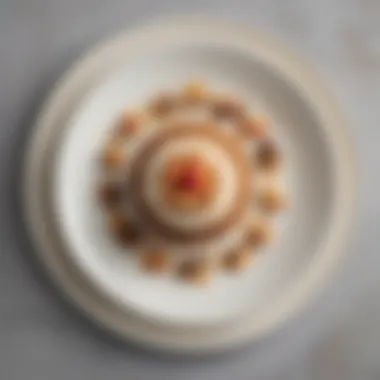Exploring Joi Almond Paste: Your Culinary Companion


Intro
Joi almond paste is a refined ingredient emerging as a staple in many cooking applications. Its flavor, texture, and adaptability offer chefs an opportunity to enhance their dishes. This guide provides insights into the essence of Joi almond paste, covering its production process, nutritional attributes, and culinary uses. This is not just a culinary trend, but rather a valuable ingredient that facilitates diverse gastronomic experiences.
Understanding Joi almond paste requires a look at its journey from raw almonds to a versatile culinary component. Whether one is a novice or a seasoned cook, this exploration aims to illuminate the various dimensions of Joi almond paste, ensuring one feels equipped to integrate it into their culinary repertoire.
"In the world of cooking, the right ingredient can elevate a dish from ordinary to extraordinary."
This guide emphasizes both the historical context of almond paste and its applications across various cuisines, allowing readers to appreciate its significance. Let's embark on this journey of discovery, diving deeper into the world of Joi almond paste.
Foreword to Joi Almond Paste
The discussion surrounding Joi almond paste is increasingly relevant in the culinary community. This ingredient boasts versatility and a distinct flavor profile that appeals to chefs and home bakers alike. Understanding the essence of Joi almond paste goes beyond merely acknowledging its taste; it involves recognizing its utility in diverse recipes and the benefits it offers to various diets.
Defining Joi Almond Paste
Joi almond paste is primarily made from ground almonds and sugar, creating a smooth, malleable texture. Unlike marzipan, which is sweeter and primarily used for confections, almond paste has a more balanced flavor, making it suitable for both sweet and savory dishes. It serves as a vital ingredient in many recipes, providing not just a flavor enhancement but also moisture and richness, which can elevate ordinary culinary endeavors.
Historical Context
The roots of almond paste trace back to ancient Mediterranean cultures, where almonds were prized for their culinary and medicinal properties. Over the centuries, the use of almond pastes spread, influencing various cuisines across Europe and Asia. In places like Italy and France, it became integral in pastries and desserts, while in Asian cuisines, almond paste may be infused into traditional sweets. This historical significance aids in appreciating not only the flavor of Joi almond paste but also its cultural importance. It reflects centuries of culinary evolution and adaptation, solidifying its place in contemporary cooking.
Production of Joi Almond Paste
The production of Joi almond paste is central to understanding its culinary value and widespread appeal. The process is not just about creating a product for consumption; it involves a delicate balance of sourcing high-quality ingredients and executing a precise manufacturing process that enhances the paste's overall flavor and texture. Such attention to detail ensures that the paste retains the rich, nutty flavor expected by chefs and home cooks alike.
Sourcing Ingredients
The quality of Joi almond paste heavily relies on the source of its main ingredient—almonds. The best almond paste is grounded in high-quality, fresh almonds. Variability exists in almond types, with sweet almonds being the most commonly used for making pastes. Growers in regions like California and Spain often produce the finest almonds, where optimal climate conditions contribute to their rich flavor.
Several factors should be considered when sourcing almonds for this purpose:
- Type of Almond: Sweet almonds are favored as they contribute less bitterness to the flavor.
- Quality: Look for raw, organic almonds to avoid additives that might compromise purity.
- Storage Conditions: Almonds should be stored in a cool, dry place to prevent rancidity before processing.
By ensuring that only the finest almonds are used, the resulting paste promises to be aromatic and flavorful, enhancing whatever dish it integrates into.
Manufacturing Process
The manufacturing of Joi almond paste is a process that deserves attention. It includes several steps that, when executed correctly, result in a high-quality product. The key stages in the manufacturing process include:
- Cleaning and Sorting: Almonds must first be cleaned to remove any debris and sorted to ensure consistent quality.
- Blanching: Some methods involve blanching to remove skins, resulting in a smoother paste.
- Milling: The cleaned almonds are then ground into a fine paste. This step is crucial as it determines the texture of the final product. The grinding can be done using traditional stone grinders or modern machinery, each affecting the flavor and consistency.
- Emulsifying Agents: Often, no additives are necessary. However, in some cases, a small amount of sugar or almond oil may be added to enhance texture and flavor.
- Packaging: Once the desired consistency is achieved, the almond paste is sealed in airtight containers to maintain freshness. Proper packaging is essential as it protects the paste from exposure to air and moisture, which can lead to spoilage.
The entire process emphasizes the need for precision at every step. By understanding the nuances of production, one can appreciate the significant role Joi almond paste plays in various culinary applications, from baking to savory dishes.
Nutritional Benefits
Understanding the nutritional benefits of Joi almond paste is essential for anyone interested in its culinary potential and health impact. Almond paste is not only a flavorful addition to various dishes but also brings numerous health advantages. A closer examination of its macro and micronutrient content reveals critical information for discerning food lovers seeking to enhance their diets.
Macro and Micronutrients
The composition of Joi almond paste is rich in essential nutrients. The primary component is almonds, which contribute significantly to both macronutrients and micronutrients. In macronutrients, almond paste primarily offers protein, healthy fats, and carbohydrates.
- Protein: Almond paste typically contains about 20% protein. This makes it a valuable source of plant-based protein, supporting muscle maintenance and repair.
- Healthy Fats: Approximately 50% of the paste is made up of healthy fats, primarily monounsaturated and polyunsaturated fats. These fats are known to improve heart health when consumed in moderation.
- Carbohydrates: Almond paste has a lower carbohydrate content, around 20%, making it suitable for various dietary preferences.


On the micronutrient side, Joi almond paste is packed with vitamins and minerals:
- Vitamin E: An important antioxidant, vitamin E supports skin health and helps protect the body from oxidative stress.
- Magnesium: This mineral is vital for numerous bodily functions, including muscle and nerve function, blood sugar control, and blood pressure regulation.
- Calcium: Almonds contain calcium, essential for bone health and maintaining a proper function of muscles and nerves.
These nutritional elements make Joi almond paste a wholesome addition to a balanced diet.
Health Benefits
The potential health benefits of Joi almond paste are extensive. Its nutrient density plays a role in improving overall wellness and tackling specific health issues.
- Heart Health: The monounsaturated fats found in almond paste can help lower bad cholesterol levels and promote good cholesterol. This contributes to a reduced risk of heart diseases.
- Weight Management: Despite being energy-dense, moderate consumption of almond paste can help with satiety due to its protein and healthy fat content, making it easier to manage weight.
- Blood Sugar Control: Almond paste has a low glycemic index, which may help prevent spikes in blood sugar levels. This is particularly important for individuals managing diabetes or those who want to maintain stable energy levels throughout the day.
“Almond paste is not just a culinary delight; it offers numerous health advantages due to its rich nutrient profile.”
Incorporating Joi almond paste into your diet can lead to various positive outcomes. From enhancing baking to adding a nutritional punch to savory dishes, understanding its benefits allows you to make informed decisions in the kitchen.
Culinary Applications
Culinary applications of Joi almond paste are essential for understanding this ingredient's versatility and potential in various dishes. This section highlights its key roles in baking, savory recipes, and desserts, emphasizing how its unique flavor can elevate culinary creations. Whether one is seeking to enhance traditional recipes or experiment with modern interpretations, Joi almond paste offers a rich, nutty note that complements a wide range of flavors.
Baking with Joi Almond Paste
Joi almond paste is a valuable ingredient in baking. It adds not only richness but also moisture to baked goods. Traditional recipes like frangipane and almond cakes benefit greatly from the paste's texture and flavor profile. Using Joi almond paste can help achieve a denser crumb, which is pleasing in cakes and pastries.
When incorporating almond paste in baking, it is crucial to blend it well with other ingredients. Here are a few tips:
- Softening: Ensure the almond paste is at room temperature before use to allow easier blending with butter or sugar.
- Ratio: When substituting almond paste for other ingredients, maintain a proper ratio to retain consistency in texture.
- Flavor Pairing: Consider flavors that complement almond, such as vanilla, chocolate, or citrus, enhancing overall taste.
Savory Dishes
Joi almond paste also finds its place in savory culinary applications. Its distinct taste can provide depth and complexity to a variety of dishes. In some Mediterranean cuisines, almond paste is used in sauces, marinades, and stuffing. It can enrich protein dishes, providing a nutty flavor that pairs well with meats or poultry.
For savory use, think about these approaches:
- Sauces: Blend almond paste into sauces for a creamy texture and to add a nutty flavor.
- Stuffing: Use it in stuffing for poultry, where it can add moisture and enhanced flavor.
- Vegetable Dishes: Incorporate almond paste in roasted vegetables or grains to give a new twist to classic sides.
Confections and Sweets
In the realm of confections and sweets, Joi almond paste shines as a fundamental ingredient. It serves as a base for many desserts, such as marzipan, and is pivotal in creating sweet fillings for pastries and candies.
When working with sweets, some key pointers include:
- Marzipan: Craft marzipan from Joi almond paste simply by adding sugar and a touch of almond extract. This creates a manageable, sweet dough for shaping and molding.
- Filling: Use almond paste as a filling for chocolates and confections. Its rich flavor complements sweet treats beautifully.
- Dessert Sauces: Integrate almond paste into dessert sauces to serve over cakes or ice cream, providing an unexpected flavor boost.
"The versatility of Joi almond paste makes it a must-have for enthusiasts who wish to explore varied culinary experiences."
Understanding these culinary applications can inspire creativity in the kitchen. Experimenting with Joi almond paste can lead to remarkable discoveries in flavor and texture across all types of dishes.
Comparison with Other Nut Pastes
Joi almond paste occupies a unique space in the world of nut pastes. While it shares characteristics with other nut-based products, such as marzipan and hazelnut paste, understanding these differences is vital for both culinary enthusiasts and chefs. This section delves into the nuances of almond paste in relation to its counterparts, enabling readers to make informed choices in their cooking and baking.


Almond Paste vs. Marzipan
Almond paste and marzipan are often confused due to their similar bases. However, the two are distinct in both composition and usage.
- Ingredients: Almond paste typically contains ground almonds, sugar, and a small amount of almond extract. Marzipan, on the other hand, has a higher sugar content and often includes egg white, giving it a sweeter taste and a smoother texture.
- Texture and Flavor: Almond paste has a coarser texture and a more pronounced almond flavor. Marzipan is smoother and tends to be sweeter, making it suitable for confectionary items.
- Culinary Uses: Almond paste is commonly used in baking and can be an addition to fillings for cakes, pastries, and cookies. Marzipan is often shaped into decorative figures or used to coat cakes. The choice here depends on the desired outcome of the recipe.
In summary, when deciding between almond paste and marzipan, consider the level of sweetness and texture you prefer for your culinary project.
Almond Paste vs. Hazelnut Paste
Hazelnut paste presents a different profile when compared to almond paste. Here are key points to consider:
- Flavor Profile: Almond paste carries a lighter, nuttier flavor. Hazelnut paste offers a richer, more intense flavor, which can be more suitable for specific desserts or savory dishes.
- Usage: While almond paste often features in traditional baked goods, hazelnut paste shines in recipes such as spreadable toppings, chocolates, and specialty desserts. This makes hazelnut paste a favorite for unique flavor combinations.
- Nutritional Content: Both pastes provide healthy fats and nutrients, but almond paste generally offers slightly higher vitamin E content. Hazelnut paste, however, boasts more fiber, making it favorable for those looking for a more fibrous option.
Ultimately, choice between almond paste and hazelnut paste hinges on the flavor intensity desired in your dish and the specific culinary application.
Storage and Shelf Life
Understanding the storage and shelf life of Joi almond paste is crucial for maintaining its quality and maximizing its culinary potential. Proper storage not only helps in preserving the flavor and texture of the paste but also plays a significant role in its safety for consumption. If stored incorrectly, Joi almond paste can lose its desired characteristics and even become spoiled. Hence, it is important to explore the optimal storage conditions and recognize the signs of spoilage to ensure that the ingredient remains at its best.
Optimal Storage Conditions
To extend the shelf life of Joi almond paste, adhering to optimal storage conditions is essential. Here are key aspects to consider:
- Temperature: Store Joi almond paste in a cool, dry place. Ideally, it should be stored at room temperature, but refrigeration can be beneficial, especially in warmer climates.
- Air Exposure: Minimizing exposure to air is important. The paste should be kept in an airtight container to prevent oxidation, which can alter its texture and flavor.
- Light Protection: Light can degrade the quality of almond paste. It is best stored in opaque or dark jars to keep it safe from light exposure.
- Humidity Control: Moisture can lead to spoilage. Ensure the storage area is low in humidity to avoid mold growth and maintain integrity of the paste.
By following these conditions, one can significantly extend the shelf life of Joi almond paste, preserving its rich flavor and creamy consistency.
Signs of Spoilage
It is essential to regularly assess the condition of Joi almond paste to prevent consumption of spoiled products. Here are some common signs to watch for:
- Off Odor: If the paste has developed a rancid or unpleasant smell, it is likely spoiled.
- Color Change: A change in color, particularly darkening or discoloration, may indicate that the almond paste has gone bad.
- Texture Alteration: If the texture becomes unusually hard or dry, or conversely, overly runny or separated, it's best to discard it.
- Mold Growth: Visible mold is a clear indicator of spoilage. If any mold is spotted, the entire batch should be discarded immediately.
It is important to conduct a sensory evaluation—using smell, sight, and touch—before using almond paste that has been stored for an extended period.
By being aware of these signs, users of Joi almond paste can manage their supply effectively, ensuring a high-quality experience in their culinary endeavors.
Choosing the Right Joi Almond Paste
Choosing the right Joi almond paste is crucial for anyone looking to enhance their culinary endeavors. The quality of almond paste can significantly impact the flavor, texture, and overall success of a dish. Given its role in a variety of recipes—from pastries to mains—selecting a suitable product is a decision that should not be taken lightly. Factors such as ingredient purity, brand reputation, and intended use are all important when navigating the many options available.
Factors to Consider
When selecting Joi almond paste, there are several factors that are worth considering:
- Ingredient Quality: Look for almond paste with minimal additives. Pure ingredients lead to better taste and texture.
- Texture: Different brands may offer almond pastes with varying textures. Depending on your recipe, you might prefer a fine grind or a coarser option. Fine almond paste is often better for confections, while coarser may add character to baked goods.
- Flavor Profile: Some almond pastes might have added flavors that can influence your dish. Always taste if possible to ensure complimentary flavor.
- Freshness: Consider the shelf life of the product. Fresh almond paste will have a more pronounced flavor and quality. Check expiration dates against purchase date.
- Packaging: Airtight packaging helps maintain freshness. Look for paste stored in vacuum-sealed containers or tubes.
Recommended Brands
Identifying trusted brands can streamline your choice, ensuring that the almond paste you select meets high standards. Here are a few prominent brands known for their quality:


- Mandan: Offers a straightforward almond paste made without preservatives. Known for its versatility and fine texture.
- Solo Foods: This brand is often recommended for its balance of quality and affordability. Excellent for both baking and confections.
- Nielsen-Massey: They provide premium flavorings and pastes, and their almond paste is recognized for its depth of flavor.
- Nutty's: With a focus on health, Nutty's provides almond paste that is organic and non-GMO, appealing to health-conscious consumers.
When selecting a brand, consider your specific culinary needs and preferences. Each of these brands provides unique qualities, so choose wisely based on your intended use.
Cultural Significance
Understanding the cultural significance of Joi almond paste reveals much about its role in various culinary traditions. Food often reflects the identity of a region, and Joi almond paste embodies flavors, techniques, and customs passed down through generations. Its versatility allows it to bridge different cuisines, making it a remarkable ingredient not just for taste, but also for cultural expression.
Almond Paste in Mediterranean Cuisine
Mediterranean cuisine holds a unique place for Joi almond paste. This region, encompassing countries like Italy, Spain, and France, has a long history of almond cultivation. Almond paste is frequently used in desserts such as frangipane, a filling made with almond cream that graces tarts and pastries. Furthermore, it is an essential component of classic sweets such as marzipan. Beyond desserts, Joi almond paste can enhance savory dishes, making it a valuable element in Mediterranean cooking.
Primarily, almonds symbolize prosperity and fertility in Mediterranean cultures. Traditionally, they are often included in wedding cakes and festive pastries, reflecting their significance in celebrations. Moreover, the wholesome nature of almonds aligns with the Mediterranean diet’s focus on health. This emphasizes their elevated status as both a culinary and symbolic ingredient.
Almond Paste in Asian Dishes
In Asia, Joi almond paste finds its place in various traditional dishes. For example, it is often used in confectionery, where it is molded into shapes or wrapped around fillings. In addition to sweets, almond paste can also be utilized in savory recipes where it adds richness and depth.
The cultural significance of almonds in Asian cuisine varies from region to region. In Chinese tradition, almonds are associated with good health and longevity. They are often featured in desserts and as part of celebratory foods during the Lunar New Year.
The adaptability of Joi almond paste in Asian dishes illustrates its culinary flexibility. As more chefs experiment with fusion cuisines, Joi almond paste keeps emerging as a vital element in innovative dishes across different cultures.
"Joi almond paste encapsulates the spirit of adaptability and creativity, transcending borders and uniting culinary worlds."
Innovative Uses of Joi Almond Paste
Joi almond paste has found its place in various culinary landscapes, serving multiple innovative functions beyond traditional applications. Embracing current trends in cooking and health, chefs and home cooks alike are utilizing this ingredient to enhance flavors, textures, and nutritional profiles in their dishes. The incorporation of Joi almond paste allows for creativity, catering to a diverse range of dietary preferences and culinary styles, which solidifies its relevance in modern kitchens.
In Modern Culinary Creations
One of the standout features of Joi almond paste is its versatility as an ingredient in modern recipes. Chefs are experimenting with its application in pastries, sauces, and even beverages. Here are some ways Joi almond paste is creatively utilized:
- Pastry Fillings: Joi almond paste can act as a rich filling for pastries, tarts, and croissants. Its smooth texture and nutty flavor complement various sweet profiles, which makes it a favorite among pastry chefs.
- Smoothies and Shakes: Adding Joi almond paste to smoothies can enhance both flavor and nutritional value. It serves as a good source of protein while adding a creamy consistency.
- Dressings and Sauces: Mixing Joi almond paste into dressings can create a unique base for salads, as well as a creamy sauce for roasted vegetables or grilled proteins.
Chefs are also focusing on global flavors by pairing Joi almond paste with spices and herbs from different cuisines. This addition helps elevate dishes, introducing a complex layer that draws diners in.
In Health-Conscious Recipes
The health benefits of Joi almond paste make it a valuable ingredient for those looking to create nutritious meals without sacrificing taste. Here are important points to consider:
- Nutritious Alternative: Joi almond paste is a healthier alternative to many commercial spreads that might be high in sugar or unhealthy fats. It contains beneficial fats, protein, and fiber, making it suitable for various diets, including gluten-free and vegetarian.
- Energy Boost: For individuals needing quick energy, incorporating Joi almond paste in snacks or meals can provide sustained energy, making it ideal for athletes or busy professionals.
- Ingredient Clarity: Since Joi almond paste often contains minimal ingredients, it aligns with the clean-eating movement. Consumers appreciate transparency regarding what they are consuming, which is why this ingredient is gaining traction.
Interestingly, the shift towards plant-based diets and increased awareness of dietary choices have further popularized the use of Joi almond paste in various recipes.
In summary, Joi almond paste serves bold purposes in modern culinary creations while supporting health-conscious eating. Its adaptability and nutrition profile present an excellent opportunity for anyone looking to expand their culinary repertoire.
Finale
The conclusion of an article acts as the final opportunity to redraw insights and emphasize the core value of the discussed topic. In the case of Joi almond paste, a concluding section serves to distill the essential elements of production, culinary applications, and nutritional benefits. This encapsulation allows readers to leave with a solid understanding of what Joi almond paste represents within the culinary landscape.
Recap of Key Points
In summary, some of the key points regarding Joi almond paste include:
- Definition and Production: Joi almond paste is a unique ingredient known for its rich flavor and versatility in both sweet and savory dishes. Understanding the sourcing of quality ingredients and the manufacturing process is critical.
- Nutritional Advantages: The paste offers several macro and micronutrients beneficial for health, thus becoming an attractive option for health-conscious individuals.
- Culinary Versatility: Its applications range from baking in pastries to enriching savory dishes and creating confections. Thus, it suits the needs of both novice and experienced cooks.
- Cultural Importance: Recognizing its place in various cuisines deepens appreciation for this ingredient and its varied uses across different cultures.
- Innovative Uses: As chefs and home cooks search for healthier options, Joi almond paste is becoming a staple in modern recipes, supporting trends towards health-conscious eating.
Final Thoughts
In close, Joi almond paste is more than just an ingredient; it is a bridge connecting rich history with modern culinary creativity. Its unique properties not only enhance flavor but also contribute nutritional benefits that many chefs prioritize today. The article emphasizes that as food lovers explore this ingredient in depth, they can unlock new dimensions in their culinary practices. The exploration of Joi almond paste reveals its integral role in not just recipes, but in cultural narratives surrounding food. Engaging with this ingredient provides an avenue for experimentation in kitchens around the world, signature creations that reflect both tradition and innovation.







